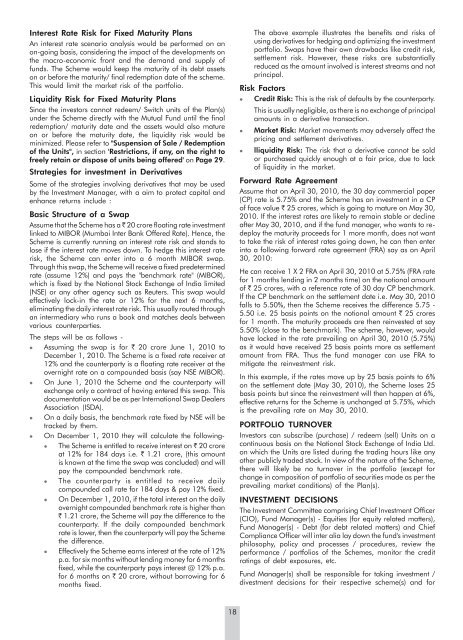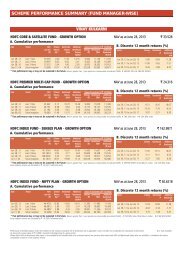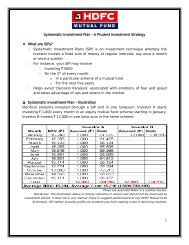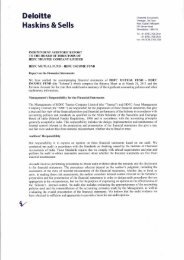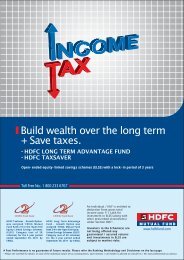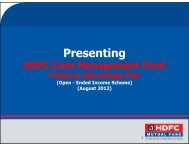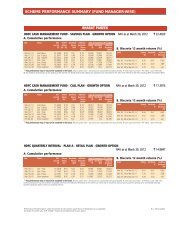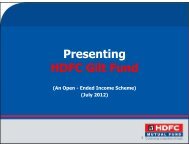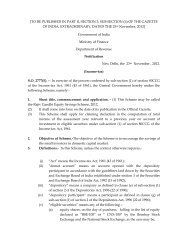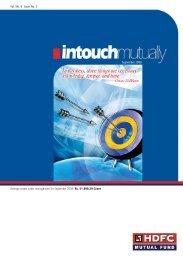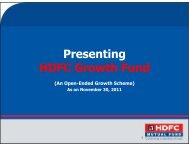HDFC Fixed Maturity Plans - Series XIX - Securities and Exchange ...
HDFC Fixed Maturity Plans - Series XIX - Securities and Exchange ...
HDFC Fixed Maturity Plans - Series XIX - Securities and Exchange ...
You also want an ePaper? Increase the reach of your titles
YUMPU automatically turns print PDFs into web optimized ePapers that Google loves.
Interest Rate Risk for <strong>Fixed</strong> <strong>Maturity</strong> <strong>Plans</strong>An interest rate scenario analysis would be performed on anon-going basis, considering the impact of the developments onthe macro-economic front <strong>and</strong> the dem<strong>and</strong> <strong>and</strong> supply offunds. The Scheme would keep the maturity of its debt assetson or before the maturity/ final redemption date of the scheme.This would limit the market risk of the portfolio.Liquidity Risk for <strong>Fixed</strong> <strong>Maturity</strong> <strong>Plans</strong>Since the investors cannot redeem/ Switch units of the Plan(s)under the Scheme directly with the Mutual Fund until the finalredemption/ maturity date <strong>and</strong> the assets would also matureon or before the maturity date, the liquidity risk would beminimized. Please refer to "Suspension of Sale / Redemptionof the Units", in section 'Restrictions, if any, on the right tofreely retain or dispose of units being offered' on Page 29.Strategies for investment in DerivativesSome of the strategies involving derivatives that may be usedby the Investment Manager, with a aim to protect capital <strong>and</strong>enhance returns include :Basic Structure of a SwapAssume that the Scheme has a M 20 crore floating rate investmentlinked to MIBOR (Mumbai Inter Bank Offered Rate). Hence, theScheme is currently running an interest rate risk <strong>and</strong> st<strong>and</strong>s tolose if the interest rate moves down. To hedge this interest raterisk, the Scheme can enter into a 6 month MIBOR swap.Through this swap, the Scheme will receive a fixed predeterminedrate (assume 12%) <strong>and</strong> pays the "benchmark rate" (MIBOR),which is fixed by the National Stock <strong>Exchange</strong> of India limited(NSE) or any other agency such as Reuters. This swap wouldeffectively lock-in the rate or 12% for the next 6 months,eliminating the daily interest rate risk. This usually routed throughan intermediary who runs a book <strong>and</strong> matches deals betweenvarious counterparties.The steps will be as follows - Assuming the swap is for M 20 crore June 1, 2010 toDecember 1, 2010. The Scheme is a fixed rate receiver at12% <strong>and</strong> the counterparty is a floating rate receiver at theovernight rate on a compounded basis (say NSE MIBOR). On June 1, 2010 the Scheme <strong>and</strong> the counterparty willexchange only a contract of having entered this swap. Thisdocumentation would be as per International Swap DealersAssociation (ISDA). On a daily basis, the benchmark rate fixed by NSE will betracked by them. On December 1, 2010 they will calculate the following- The Scheme is entitled to receive interest on M 20 croreat 12% for 184 days i.e. M 1.21 crore, (this amountis known at the time the swap was concluded) <strong>and</strong> willpay the compounded benchmark rate. The counterparty is entitled to receive dailycompounded call rate for 184 days & pay 12% fixed. On December 1, 2010, if the total interest on the dailyovernight compounded benchmark rate is higher thanM 1.21 crore, the Scheme will pay the difference to thecounterparty. If the daily compounded benchmarkrate is lower, then the counterparty will pay the Schemethe difference. Effectively the Scheme earns interest at the rate of 12%p.a. for six months without lending money for 6 monthsfixed, while the counterparty pays interest @ 12% p.a.for 6 months on M 20 crore, without borrowing for 6months fixed.The above example illustrates the benefits <strong>and</strong> risks ofusing derivatives for hedging <strong>and</strong> optimizing the investmentportfolio. Swaps have their own drawbacks like credit risk,settlement risk. However, these risks are substantiallyreduced as the amount involved is interest streams <strong>and</strong> notprincipal.Risk Factors Credit Risk: This is the risk of defaults by the counterparty.This is usually negligible, as there is no exchange of principalamounts in a derivative transaction. Market Risk: Market movements may adversely affect thepricing <strong>and</strong> settlement derivatives. lliquidity Risk: The risk that a derivative cannot be soldor purchased quickly enough at a fair price, due to lackof liquidity in the market.Forward Rate AgreementAssume that on April 30, 2010, the 30 day commercial paper(CP) rate is 5.75% <strong>and</strong> the Scheme has an investment in a CPof face value M 25 crores, which is going to mature on May 30,2010. If the interest rates are likely to remain stable or declineafter May 30, 2010, <strong>and</strong> if the fund manager, who wants to redeploythe maturity proceeds for 1 more month, does not wantto take the risk of interest rates going down, he can then enterinto a following forward rate agreement (FRA) say as on April30, 2010:He can receive 1 X 2 FRA on April 30, 2010 at 5.75% (FRA ratefor 1 months lending in 2 months time) on the notional amountof M 25 crores, with a reference rate of 30 day CP benchmark.If the CP benchmark on the settlement date i.e. May 30, 2010falls to 5.50%, then the Scheme receives the difference 5.75 -5.50 i.e. 25 basis points on the notional amount M 25 croresfor 1 month. The maturity proceeds are then reinvested at say5.50% (close to the benchmark). The scheme, however, wouldhave locked in the rate prevailing on April 30, 2010 (5.75%)as it would have received 25 basis points more as settlementamount from FRA. Thus the fund manager can use FRA tomitigate the reinvestment risk.In this example, if the rates move up by 25 basis points to 6%on the settlement date (May 30, 2010), the Scheme loses 25basis points but since the reinvestment will then happen at 6%,effective returns for the Scheme is unchanged at 5.75%, whichis the prevailing rate on May 30, 2010.PORTFOLIO TURNOVERInvestors can subscribe (purchase) / redeem (sell) Units on acontinuous basis on the National Stock <strong>Exchange</strong> of India Ltd.on which the Units are listed during the trading hours like anyother publicly traded stock. In view of the nature of the Scheme,there will likely be no turnover in the portfolio (except forchange in composition of portfolio of securities made as per theprevailing market conditions) of the Plan(s).INVESTMENT DECISIONSThe Investment Committee comprising Chief Investment Officer(CIO), Fund Manager(s) - Equities (for equity related matters),Fund Manager(s) - Debt (for debt related matters) <strong>and</strong> ChiefCompliance Officer will inter alia lay down the fund's investmentphilosophy, policy <strong>and</strong> processes / procedures, review theperformance / portfolios of the Schemes, monitor the creditratings of debt exposures, etc.Fund Manager(s) shall be responsible for taking investment /divestment decisions for their respective scheme(s) <strong>and</strong> for18


